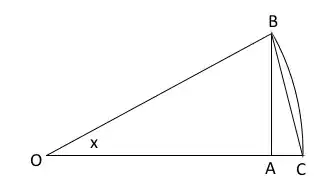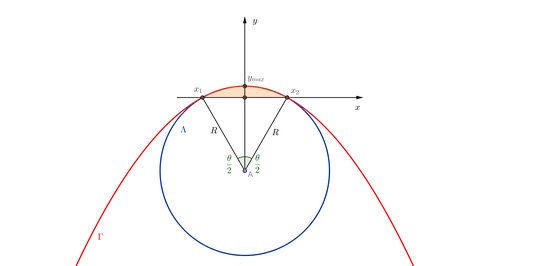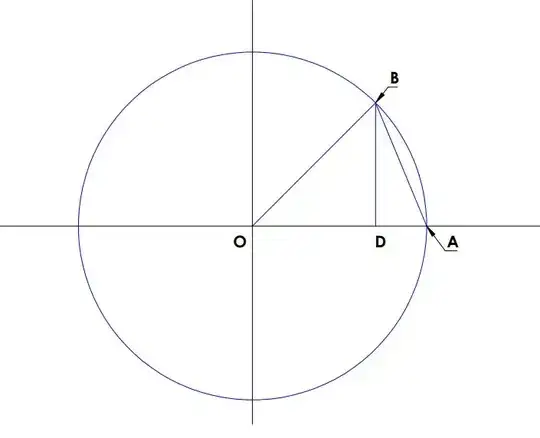Now a full answer (assuming we have a result slightly stronger than yours, that $\cos x = 1-\frac{x^2}{2}+o(x^2)$, which is the true meaning of $\cos x\sim 1-\frac{x^2}{2}$, but which you haven't proven - you haven't come up with a bound for your error.)
Let $D$ be the midpoint of the arc in $MA$. The area of the quadrilateral $OMDA$ is $\frac{\sin(x)}{2}$.
The area of circular wedge between $M$ and $A$ is $\frac{x}{2}$.
Taking the tangents to the circle at $M$ and $A$ and finding their intersection, $C$, you get that the are of $OMCA$ is $2\tan(x/2)$. So you have:
$$\sin\frac{x}{2}<\frac{x}{2}<\tan\frac{x}{2}$$
Setting $u=\frac{x}{2}$ you get:
$$\sin u< u < \frac{\sin u}{\cos u}$$
Or $\cos u<\frac{\sin u}{u}<1$
This is enough to see that $\sin u = u+O(u^3)$ (using that $\cos(u)=1+O(u^2)$,) but not enough to show what you want.
The goal is to find and approximation of the difference $u-\sin u$, twice the area of the region between the line segment $AD$ and the arc $AD$.
Letting $$A_n=\frac{1}2\sin \frac{x}{2^{n}},$$ is the area of $2^{n}$ copies of the triangle $MOA$ with angle $\frac{x}{2^n}$. From this, we see that $2^{n}A_n<\frac{x}{2}$, since the $2^n$ triangles fit inside the wedge.
Now, $A_{n+1}$ is gotten by taking half of the triangle for $A_{n+1}$ and adding a triangle with base $\sin(x/2^{n+1})$ and height $1-\cos(x/2^{n+1})$.
So: $$A_{n+1}=\frac{A_n}{2}+\frac{1}{2}\sin(x/2^{n+1})(1-\cos(x/2^{n+1})).$$
So if $B_{n}=2^{n}A_n$, then $B_0=\frac{\sin x}{2}$ and $$B_{n+1}=B_n+2^{n}\sin(x/2^{n+1})(1-\cos(x/2^{n+1})).$$
Writing $f(x)=x-\sin x$ and $g(x)=\cos x-1+\frac{x^2}{2}$ as our error functions. We get:
$$\begin{align}B_{n+1}-B_{n}&=2^{n}\sin(x/2^{n+1})(1-\cos(x/2^{n+1}))\\&=2^{n}\left(\frac{x}{2^{n+1}}+f\left(\frac{x}{2^{n+1}}\right)\right) \left(\frac{x^2}{2^{2n+3}}+g\left(\frac{x}{2^{n+1}}\right)\right)\\
&=\frac{x^3}{2^{2n+4}}+\frac{x}{2}g\left(\frac{x}{2^{n+1}}\right)+\frac{x^2}{2^{n+3}}f\left(\frac{x}{2^{n+1}}\right)+f\left(\frac{x}{2^{n+1}}\right)g\left(\frac{x}{2^{n+1}}\right)
\end{align}$$
Now, we know that $f(x)=O(x^3)$ and $g(x)=o(x^2)$, so we get:
$$\begin{align}\lim_{n\to\infty} B_n &= B_0+\sum_{n=0}^{\infty}\left(B_{n+1}-B_n\right)\\
&=\frac{\sin x}{2}+\left(x^3\sum_{n=0}^{\infty}\frac{1}{2^{2n+4}}\right)+o(x^3)+O(x^5)+o(x^5)\\
&=\frac{\sin x}{2}+\frac{x^3}{12}+o(x^3)
\end{align}$$
But $\lim_{n\to\infty} B_n =\frac{x}{2}$, because this is the area of the circular wedge.
So we have: $$x-\sin x = \frac{x^3}{6} + o(x^3)$$
You can actually prove that $B_n\to \frac{x}{2}$ by noting that $\frac{B_{n}}{\cos(x/2^n)}$ is the area of $2^n$ triangles that cover the circular wedge, and thus you have:
$$B_n<\frac{x}{2}<\frac{B_n}{\cos(x/2^n)}$$
Simce $B_n$ is increasing, and $\cos(x/2^n)\to 1$, we see that both values converge to $\frac{x}{2}$.
The full proof first prove that $\sin x = x+o(x)$.
From this, though, we can show that:
$$\cos(x)=1-2\sin^2 \frac{x}{2} = 1-\frac{x^2}{2}+o(x^2).$$
Then the rest of the argument follows, since $\cos(x)=1+O(u^2)$.




In other words, it's stronger than just being "approximately" equal in a loose sense.
I don't see how this geometric proof establishes the above limit.
– MathematicsStudent1122 Aug 10 '17 at 20:24